The Relationship Between Airline Industry Growth and GDP Growth
VerifiedAdded on 2022/10/19
|10
|1915
|6
Case Study
AI Summary
This case study analyzes the growth of the US airline industry and its relationship with the country's GDP. It examines the industry's growth over the last decade, highlighting the positive correlation between GDP growth and airline industry expansion, driven primarily by increased disposable income and investment in the sector. The analysis includes an examination of the impact of the airline industry on GDP, the influence of different stages of the business cycle, and the role of factors like changes in regulations. The study uses data visualizations to illustrate key trends, such as increasing passenger numbers, freight value, and investment in the aviation sector. The study concludes that the airline industry is a significant contributor to the national economy, with its output level being influenced by various economic indicators and business cycle phases, and its growth is dependent on factors such as per capita disposable income. The study also finds that the airline industry helps in the development of other related industries of the economy as well.
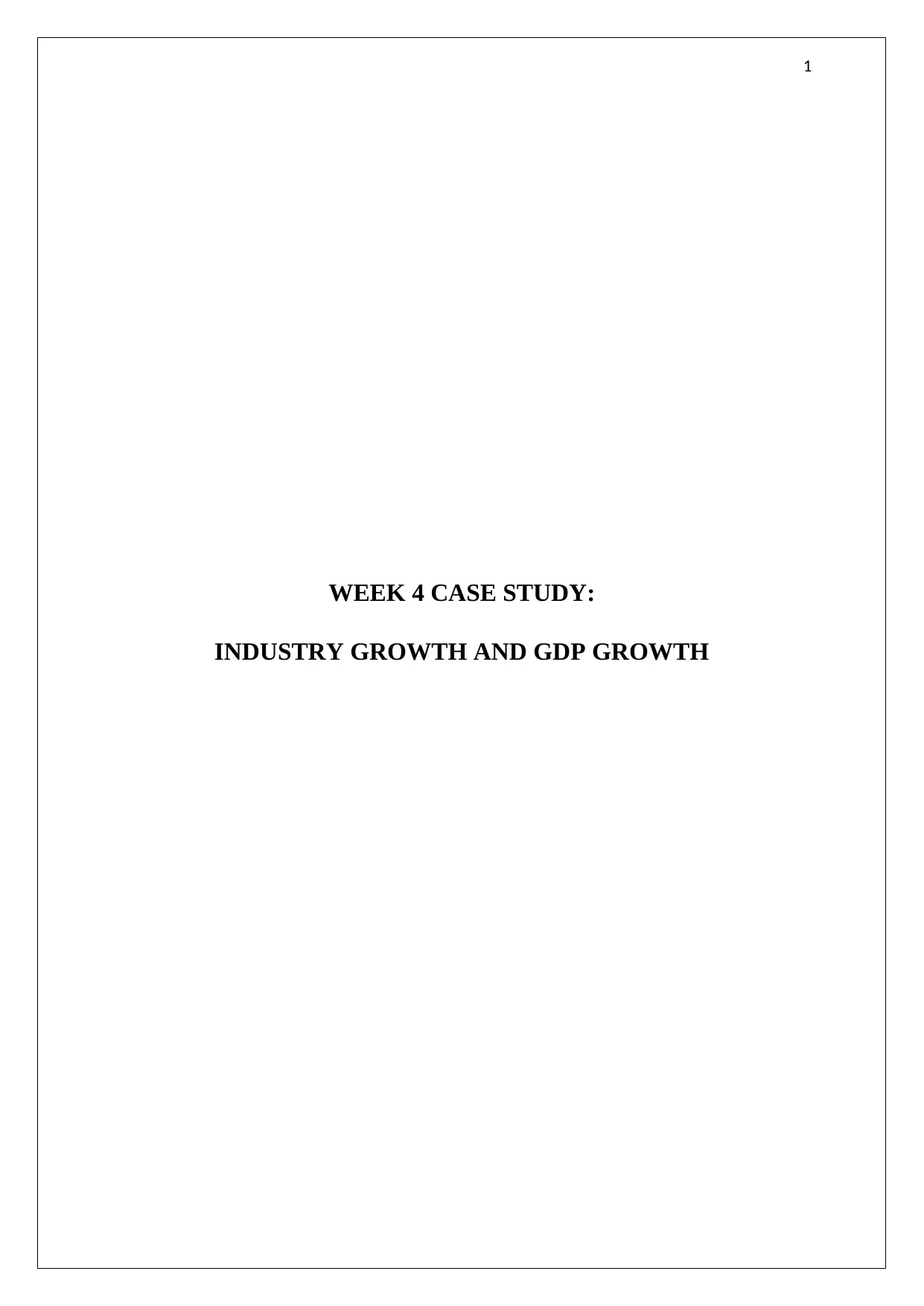
1
WEEK 4 CASE STUDY:
INDUSTRY GROWTH AND GDP GROWTH
WEEK 4 CASE STUDY:
INDUSTRY GROWTH AND GDP GROWTH
Paraphrase This Document
Need a fresh take? Get an instant paraphrase of this document with our AI Paraphraser
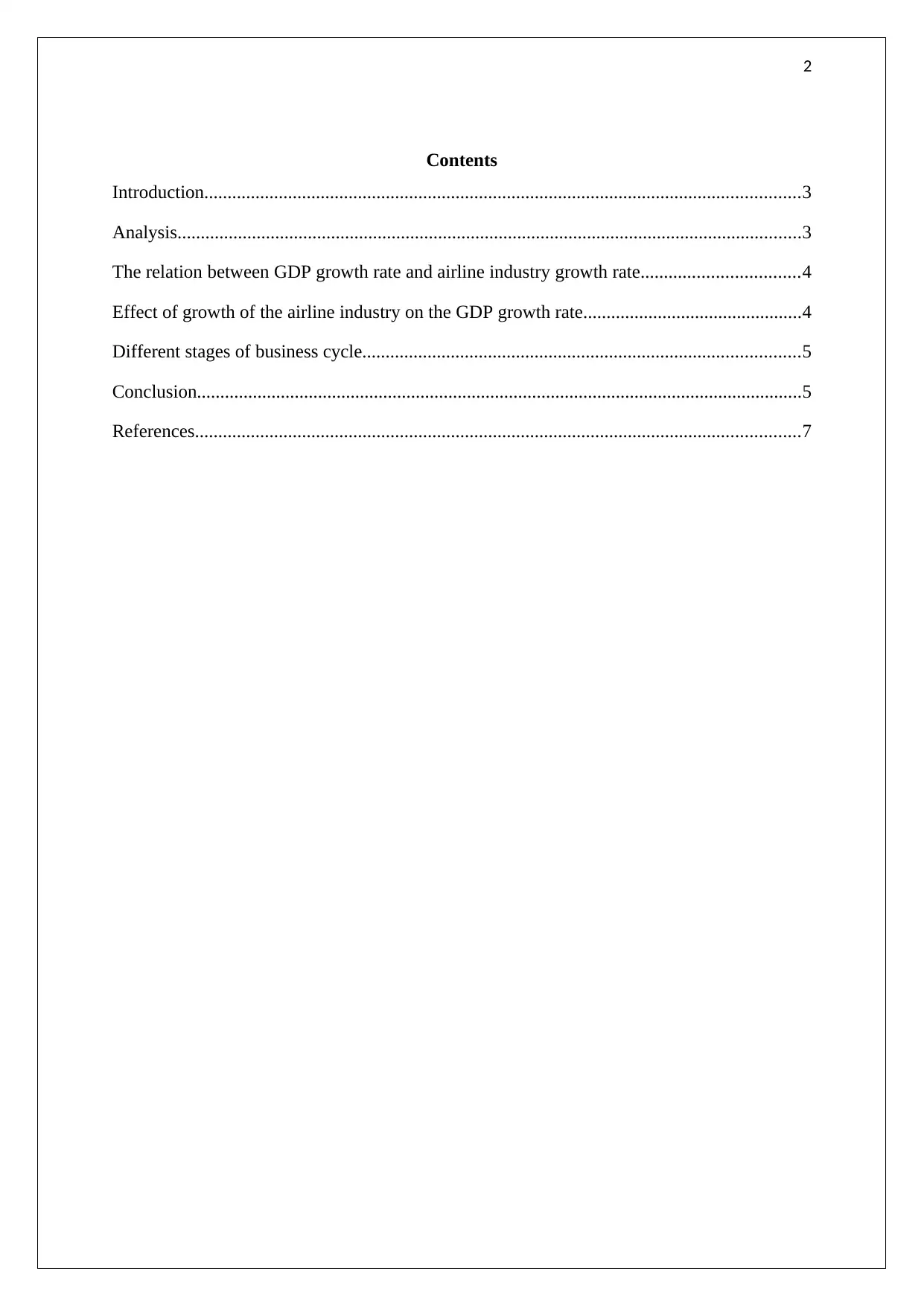
2
Contents
Introduction................................................................................................................................3
Analysis......................................................................................................................................3
The relation between GDP growth rate and airline industry growth rate..................................4
Effect of growth of the airline industry on the GDP growth rate...............................................4
Different stages of business cycle..............................................................................................5
Conclusion..................................................................................................................................5
References..................................................................................................................................7
Contents
Introduction................................................................................................................................3
Analysis......................................................................................................................................3
The relation between GDP growth rate and airline industry growth rate..................................4
Effect of growth of the airline industry on the GDP growth rate...............................................4
Different stages of business cycle..............................................................................................5
Conclusion..................................................................................................................................5
References..................................................................................................................................7
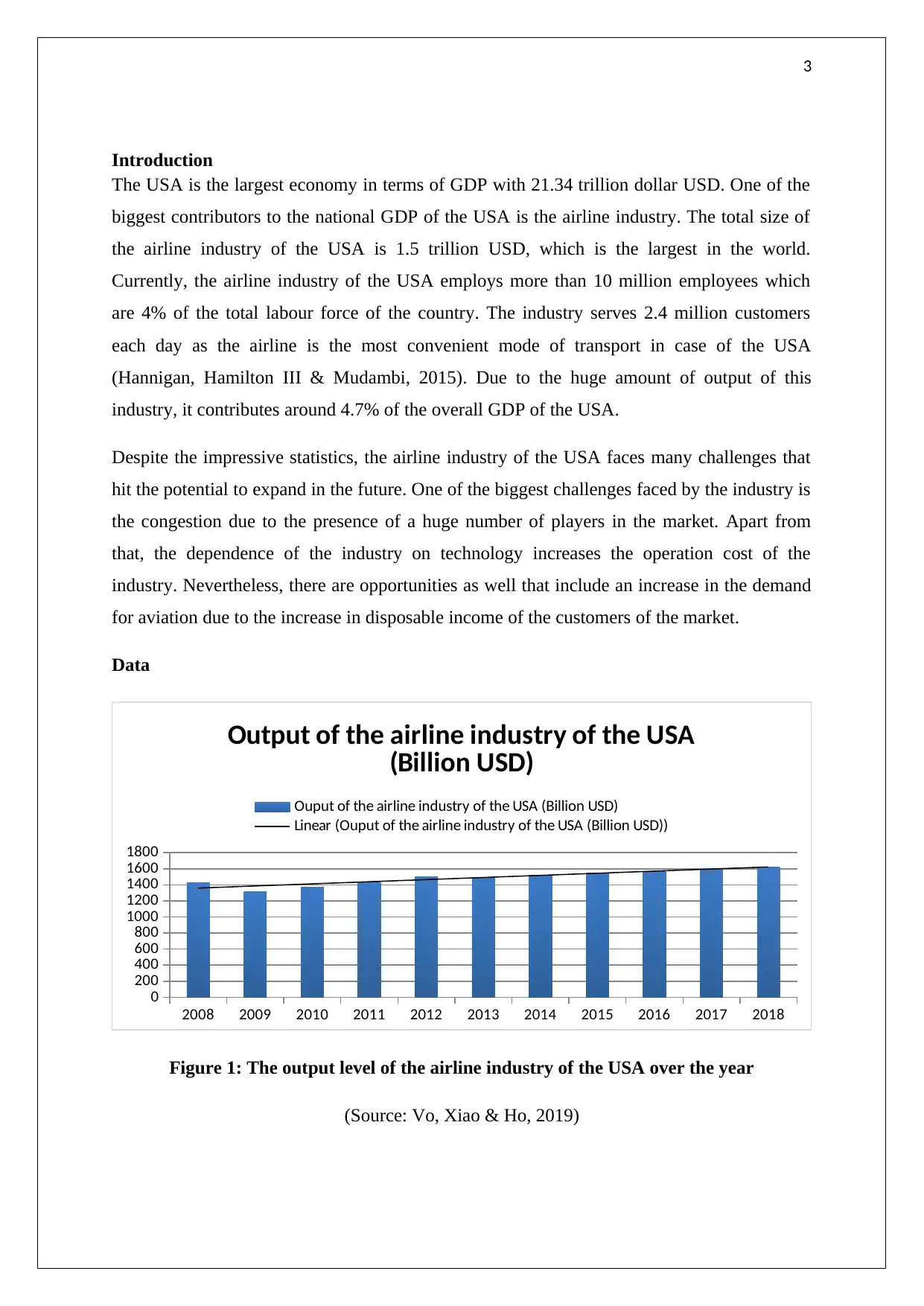
3
Introduction
The USA is the largest economy in terms of GDP with 21.34 trillion dollar USD. One of the
biggest contributors to the national GDP of the USA is the airline industry. The total size of
the airline industry of the USA is 1.5 trillion USD, which is the largest in the world.
Currently, the airline industry of the USA employs more than 10 million employees which
are 4% of the total labour force of the country. The industry serves 2.4 million customers
each day as the airline is the most convenient mode of transport in case of the USA
(Hannigan, Hamilton III & Mudambi, 2015). Due to the huge amount of output of this
industry, it contributes around 4.7% of the overall GDP of the USA.
Despite the impressive statistics, the airline industry of the USA faces many challenges that
hit the potential to expand in the future. One of the biggest challenges faced by the industry is
the congestion due to the presence of a huge number of players in the market. Apart from
that, the dependence of the industry on technology increases the operation cost of the
industry. Nevertheless, there are opportunities as well that include an increase in the demand
for aviation due to the increase in disposable income of the customers of the market.
Data
2008 2009 2010 2011 2012 2013 2014 2015 2016 2017 2018
0
200
400
600
800
1000
1200
1400
1600
1800
Output of the airline industry of the USA
(Billion USD)
Ouput of the airline industry of the USA (Billion USD)
Linear (Ouput of the airline industry of the USA (Billion USD))
Figure 1: The output level of the airline industry of the USA over the year
(Source: Vo, Xiao & Ho, 2019)
Introduction
The USA is the largest economy in terms of GDP with 21.34 trillion dollar USD. One of the
biggest contributors to the national GDP of the USA is the airline industry. The total size of
the airline industry of the USA is 1.5 trillion USD, which is the largest in the world.
Currently, the airline industry of the USA employs more than 10 million employees which
are 4% of the total labour force of the country. The industry serves 2.4 million customers
each day as the airline is the most convenient mode of transport in case of the USA
(Hannigan, Hamilton III & Mudambi, 2015). Due to the huge amount of output of this
industry, it contributes around 4.7% of the overall GDP of the USA.
Despite the impressive statistics, the airline industry of the USA faces many challenges that
hit the potential to expand in the future. One of the biggest challenges faced by the industry is
the congestion due to the presence of a huge number of players in the market. Apart from
that, the dependence of the industry on technology increases the operation cost of the
industry. Nevertheless, there are opportunities as well that include an increase in the demand
for aviation due to the increase in disposable income of the customers of the market.
Data
2008 2009 2010 2011 2012 2013 2014 2015 2016 2017 2018
0
200
400
600
800
1000
1200
1400
1600
1800
Output of the airline industry of the USA
(Billion USD)
Ouput of the airline industry of the USA (Billion USD)
Linear (Ouput of the airline industry of the USA (Billion USD))
Figure 1: The output level of the airline industry of the USA over the year
(Source: Vo, Xiao & Ho, 2019)
⊘ This is a preview!⊘
Do you want full access?
Subscribe today to unlock all pages.

Trusted by 1+ million students worldwide
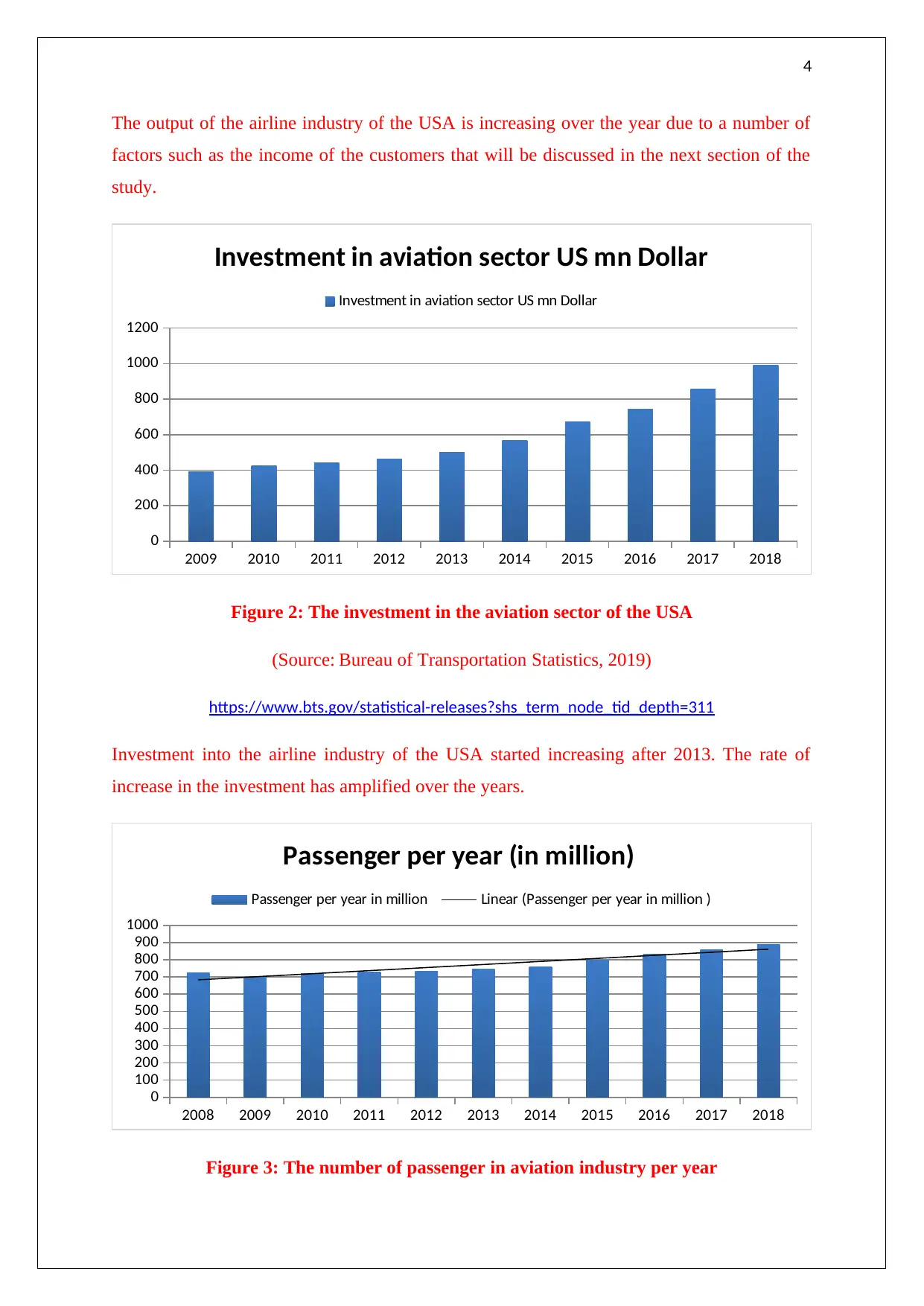
4
The output of the airline industry of the USA is increasing over the year due to a number of
factors such as the income of the customers that will be discussed in the next section of the
study.
2009 2010 2011 2012 2013 2014 2015 2016 2017 2018
0
200
400
600
800
1000
1200
Investment in aviation sector US mn Dollar
Investment in aviation sector US mn Dollar
Figure 2: The investment in the aviation sector of the USA
(Source: Bureau of Transportation Statistics, 2019)
https://www.bts.gov/statistical-releases?shs_term_node_tid_depth=311
Investment into the airline industry of the USA started increasing after 2013. The rate of
increase in the investment has amplified over the years.
2008 2009 2010 2011 2012 2013 2014 2015 2016 2017 2018
0
100
200
300
400
500
600
700
800
900
1000
Passenger per year (in million)
Passenger per year in million Linear (Passenger per year in million )
Figure 3: The number of passenger in aviation industry per year
The output of the airline industry of the USA is increasing over the year due to a number of
factors such as the income of the customers that will be discussed in the next section of the
study.
2009 2010 2011 2012 2013 2014 2015 2016 2017 2018
0
200
400
600
800
1000
1200
Investment in aviation sector US mn Dollar
Investment in aviation sector US mn Dollar
Figure 2: The investment in the aviation sector of the USA
(Source: Bureau of Transportation Statistics, 2019)
https://www.bts.gov/statistical-releases?shs_term_node_tid_depth=311
Investment into the airline industry of the USA started increasing after 2013. The rate of
increase in the investment has amplified over the years.
2008 2009 2010 2011 2012 2013 2014 2015 2016 2017 2018
0
100
200
300
400
500
600
700
800
900
1000
Passenger per year (in million)
Passenger per year in million Linear (Passenger per year in million )
Figure 3: The number of passenger in aviation industry per year
Paraphrase This Document
Need a fresh take? Get an instant paraphrase of this document with our AI Paraphraser
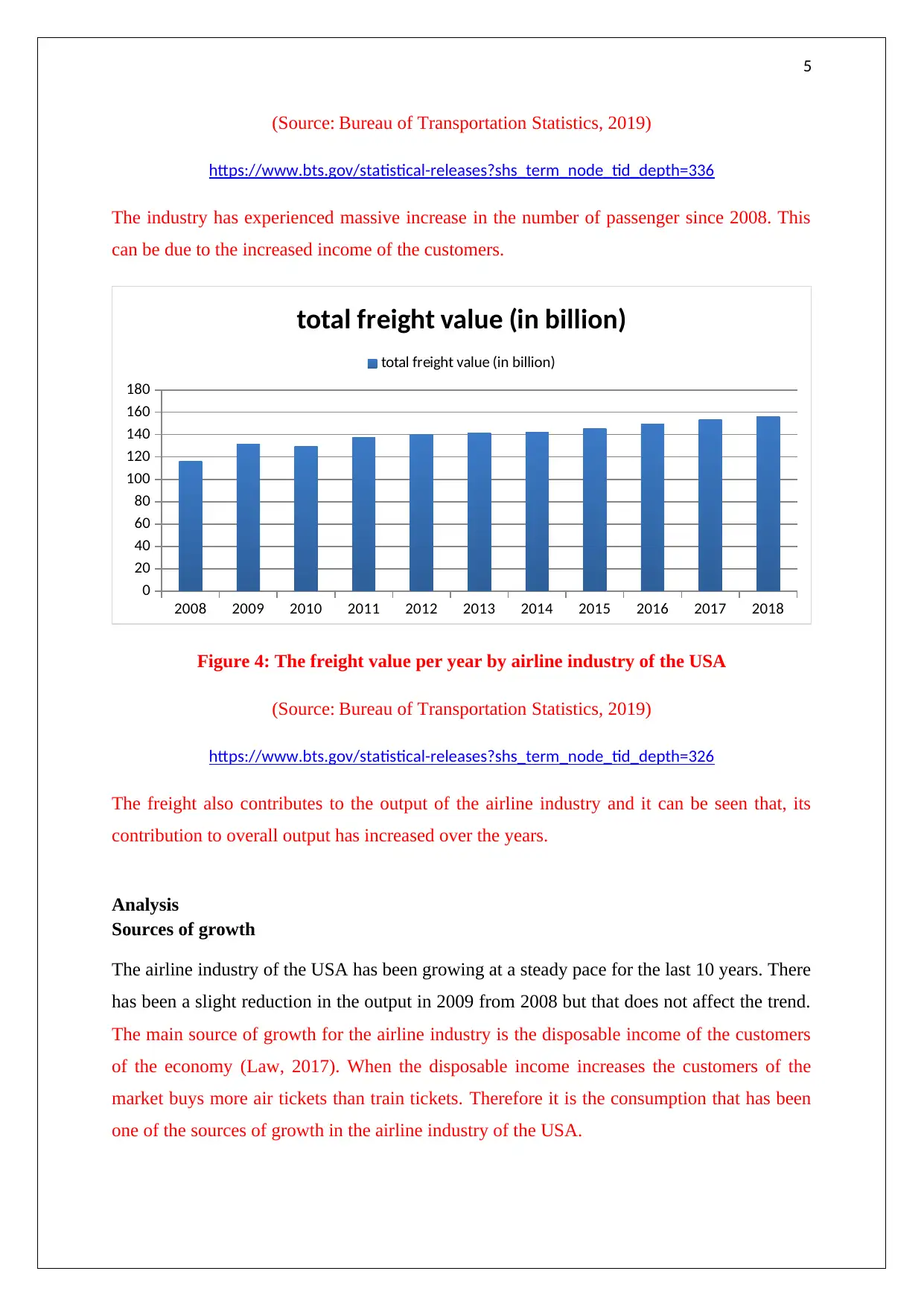
5
(Source: Bureau of Transportation Statistics, 2019)
https://www.bts.gov/statistical-releases?shs_term_node_tid_depth=336
The industry has experienced massive increase in the number of passenger since 2008. This
can be due to the increased income of the customers.
2008 2009 2010 2011 2012 2013 2014 2015 2016 2017 2018
0
20
40
60
80
100
120
140
160
180
total freight value (in billion)
total freight value (in billion)
Figure 4: The freight value per year by airline industry of the USA
(Source: Bureau of Transportation Statistics, 2019)
https://www.bts.gov/statistical-releases?shs_term_node_tid_depth=326
The freight also contributes to the output of the airline industry and it can be seen that, its
contribution to overall output has increased over the years.
Analysis
Sources of growth
The airline industry of the USA has been growing at a steady pace for the last 10 years. There
has been a slight reduction in the output in 2009 from 2008 but that does not affect the trend.
The main source of growth for the airline industry is the disposable income of the customers
of the economy (Law, 2017). When the disposable income increases the customers of the
market buys more air tickets than train tickets. Therefore it is the consumption that has been
one of the sources of growth in the airline industry of the USA.
(Source: Bureau of Transportation Statistics, 2019)
https://www.bts.gov/statistical-releases?shs_term_node_tid_depth=336
The industry has experienced massive increase in the number of passenger since 2008. This
can be due to the increased income of the customers.
2008 2009 2010 2011 2012 2013 2014 2015 2016 2017 2018
0
20
40
60
80
100
120
140
160
180
total freight value (in billion)
total freight value (in billion)
Figure 4: The freight value per year by airline industry of the USA
(Source: Bureau of Transportation Statistics, 2019)
https://www.bts.gov/statistical-releases?shs_term_node_tid_depth=326
The freight also contributes to the output of the airline industry and it can be seen that, its
contribution to overall output has increased over the years.
Analysis
Sources of growth
The airline industry of the USA has been growing at a steady pace for the last 10 years. There
has been a slight reduction in the output in 2009 from 2008 but that does not affect the trend.
The main source of growth for the airline industry is the disposable income of the customers
of the economy (Law, 2017). When the disposable income increases the customers of the
market buys more air tickets than train tickets. Therefore it is the consumption that has been
one of the sources of growth in the airline industry of the USA.
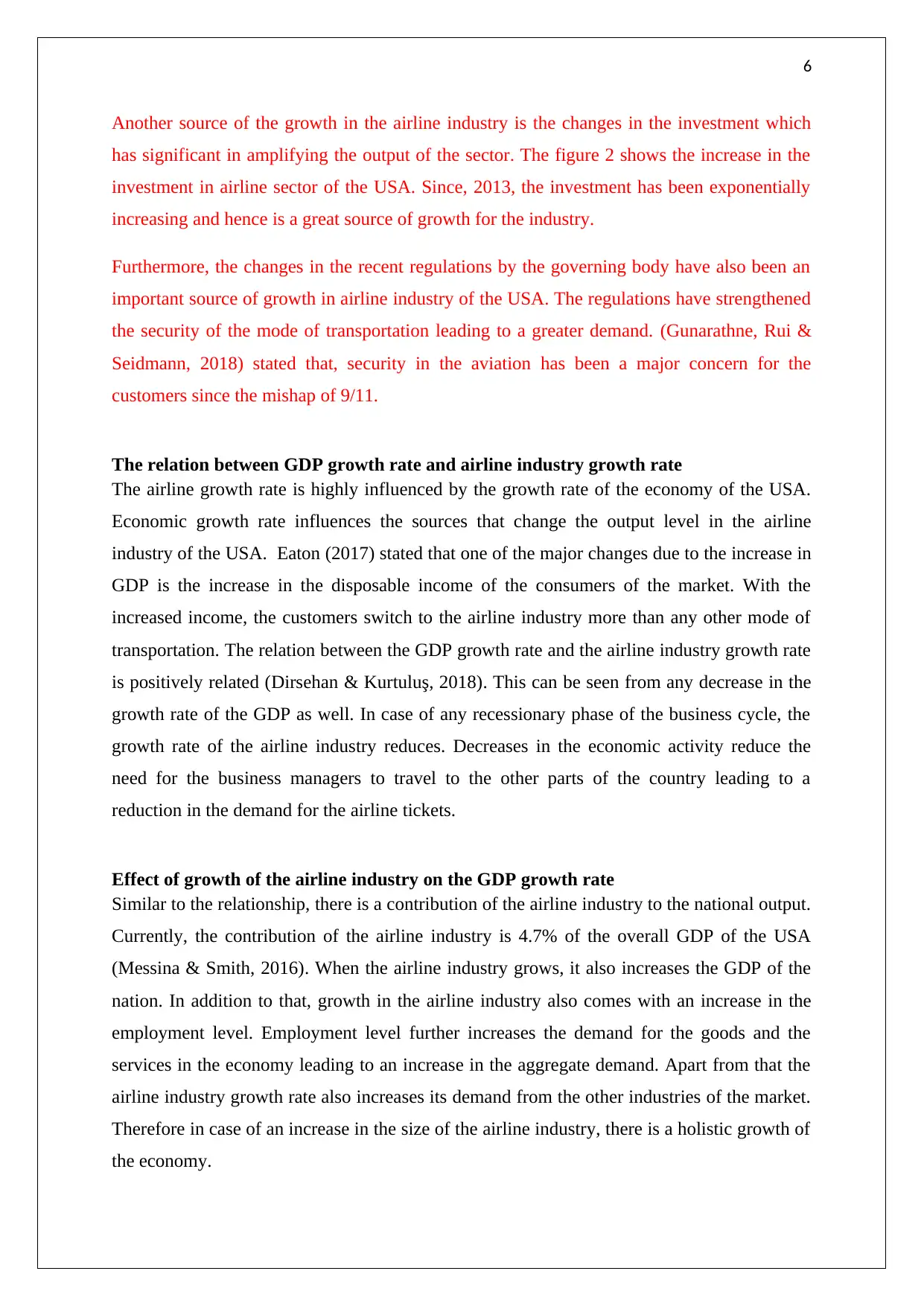
6
Another source of the growth in the airline industry is the changes in the investment which
has significant in amplifying the output of the sector. The figure 2 shows the increase in the
investment in airline sector of the USA. Since, 2013, the investment has been exponentially
increasing and hence is a great source of growth for the industry.
Furthermore, the changes in the recent regulations by the governing body have also been an
important source of growth in airline industry of the USA. The regulations have strengthened
the security of the mode of transportation leading to a greater demand. (Gunarathne, Rui &
Seidmann, 2018) stated that, security in the aviation has been a major concern for the
customers since the mishap of 9/11.
The relation between GDP growth rate and airline industry growth rate
The airline growth rate is highly influenced by the growth rate of the economy of the USA.
Economic growth rate influences the sources that change the output level in the airline
industry of the USA. Eaton (2017) stated that one of the major changes due to the increase in
GDP is the increase in the disposable income of the consumers of the market. With the
increased income, the customers switch to the airline industry more than any other mode of
transportation. The relation between the GDP growth rate and the airline industry growth rate
is positively related (Dirsehan & Kurtuluş, 2018). This can be seen from any decrease in the
growth rate of the GDP as well. In case of any recessionary phase of the business cycle, the
growth rate of the airline industry reduces. Decreases in the economic activity reduce the
need for the business managers to travel to the other parts of the country leading to a
reduction in the demand for the airline tickets.
Effect of growth of the airline industry on the GDP growth rate
Similar to the relationship, there is a contribution of the airline industry to the national output.
Currently, the contribution of the airline industry is 4.7% of the overall GDP of the USA
(Messina & Smith, 2016). When the airline industry grows, it also increases the GDP of the
nation. In addition to that, growth in the airline industry also comes with an increase in the
employment level. Employment level further increases the demand for the goods and the
services in the economy leading to an increase in the aggregate demand. Apart from that the
airline industry growth rate also increases its demand from the other industries of the market.
Therefore in case of an increase in the size of the airline industry, there is a holistic growth of
the economy.
Another source of the growth in the airline industry is the changes in the investment which
has significant in amplifying the output of the sector. The figure 2 shows the increase in the
investment in airline sector of the USA. Since, 2013, the investment has been exponentially
increasing and hence is a great source of growth for the industry.
Furthermore, the changes in the recent regulations by the governing body have also been an
important source of growth in airline industry of the USA. The regulations have strengthened
the security of the mode of transportation leading to a greater demand. (Gunarathne, Rui &
Seidmann, 2018) stated that, security in the aviation has been a major concern for the
customers since the mishap of 9/11.
The relation between GDP growth rate and airline industry growth rate
The airline growth rate is highly influenced by the growth rate of the economy of the USA.
Economic growth rate influences the sources that change the output level in the airline
industry of the USA. Eaton (2017) stated that one of the major changes due to the increase in
GDP is the increase in the disposable income of the consumers of the market. With the
increased income, the customers switch to the airline industry more than any other mode of
transportation. The relation between the GDP growth rate and the airline industry growth rate
is positively related (Dirsehan & Kurtuluş, 2018). This can be seen from any decrease in the
growth rate of the GDP as well. In case of any recessionary phase of the business cycle, the
growth rate of the airline industry reduces. Decreases in the economic activity reduce the
need for the business managers to travel to the other parts of the country leading to a
reduction in the demand for the airline tickets.
Effect of growth of the airline industry on the GDP growth rate
Similar to the relationship, there is a contribution of the airline industry to the national output.
Currently, the contribution of the airline industry is 4.7% of the overall GDP of the USA
(Messina & Smith, 2016). When the airline industry grows, it also increases the GDP of the
nation. In addition to that, growth in the airline industry also comes with an increase in the
employment level. Employment level further increases the demand for the goods and the
services in the economy leading to an increase in the aggregate demand. Apart from that the
airline industry growth rate also increases its demand from the other industries of the market.
Therefore in case of an increase in the size of the airline industry, there is a holistic growth of
the economy.
⊘ This is a preview!⊘
Do you want full access?
Subscribe today to unlock all pages.

Trusted by 1+ million students worldwide
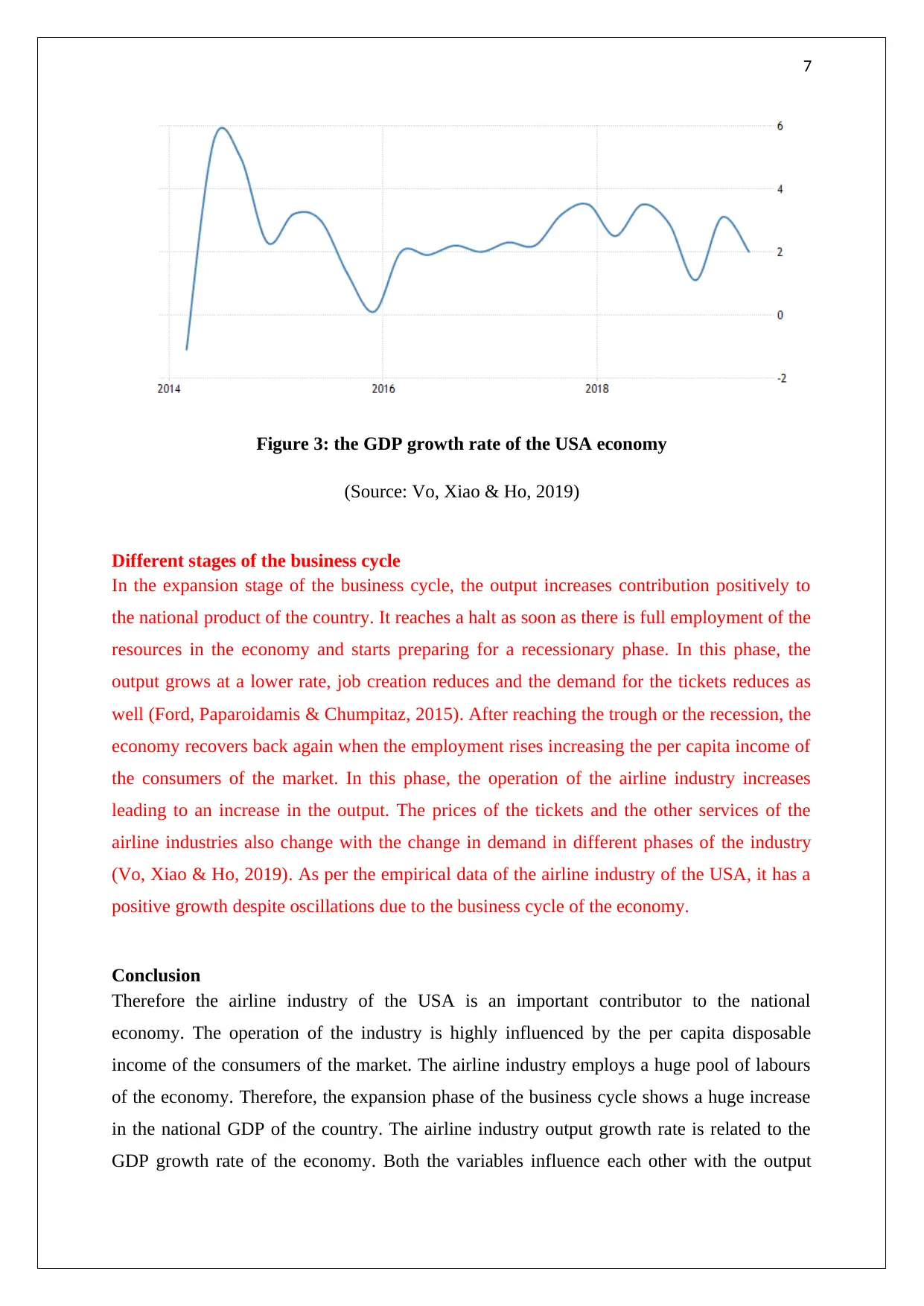
7
Figure 3: the GDP growth rate of the USA economy
(Source: Vo, Xiao & Ho, 2019)
Different stages of the business cycle
In the expansion stage of the business cycle, the output increases contribution positively to
the national product of the country. It reaches a halt as soon as there is full employment of the
resources in the economy and starts preparing for a recessionary phase. In this phase, the
output grows at a lower rate, job creation reduces and the demand for the tickets reduces as
well (Ford, Paparoidamis & Chumpitaz, 2015). After reaching the trough or the recession, the
economy recovers back again when the employment rises increasing the per capita income of
the consumers of the market. In this phase, the operation of the airline industry increases
leading to an increase in the output. The prices of the tickets and the other services of the
airline industries also change with the change in demand in different phases of the industry
(Vo, Xiao & Ho, 2019). As per the empirical data of the airline industry of the USA, it has a
positive growth despite oscillations due to the business cycle of the economy.
Conclusion
Therefore the airline industry of the USA is an important contributor to the national
economy. The operation of the industry is highly influenced by the per capita disposable
income of the consumers of the market. The airline industry employs a huge pool of labours
of the economy. Therefore, the expansion phase of the business cycle shows a huge increase
in the national GDP of the country. The airline industry output growth rate is related to the
GDP growth rate of the economy. Both the variables influence each other with the output
Figure 3: the GDP growth rate of the USA economy
(Source: Vo, Xiao & Ho, 2019)
Different stages of the business cycle
In the expansion stage of the business cycle, the output increases contribution positively to
the national product of the country. It reaches a halt as soon as there is full employment of the
resources in the economy and starts preparing for a recessionary phase. In this phase, the
output grows at a lower rate, job creation reduces and the demand for the tickets reduces as
well (Ford, Paparoidamis & Chumpitaz, 2015). After reaching the trough or the recession, the
economy recovers back again when the employment rises increasing the per capita income of
the consumers of the market. In this phase, the operation of the airline industry increases
leading to an increase in the output. The prices of the tickets and the other services of the
airline industries also change with the change in demand in different phases of the industry
(Vo, Xiao & Ho, 2019). As per the empirical data of the airline industry of the USA, it has a
positive growth despite oscillations due to the business cycle of the economy.
Conclusion
Therefore the airline industry of the USA is an important contributor to the national
economy. The operation of the industry is highly influenced by the per capita disposable
income of the consumers of the market. The airline industry employs a huge pool of labours
of the economy. Therefore, the expansion phase of the business cycle shows a huge increase
in the national GDP of the country. The airline industry output growth rate is related to the
GDP growth rate of the economy. Both the variables influence each other with the output
Paraphrase This Document
Need a fresh take? Get an instant paraphrase of this document with our AI Paraphraser
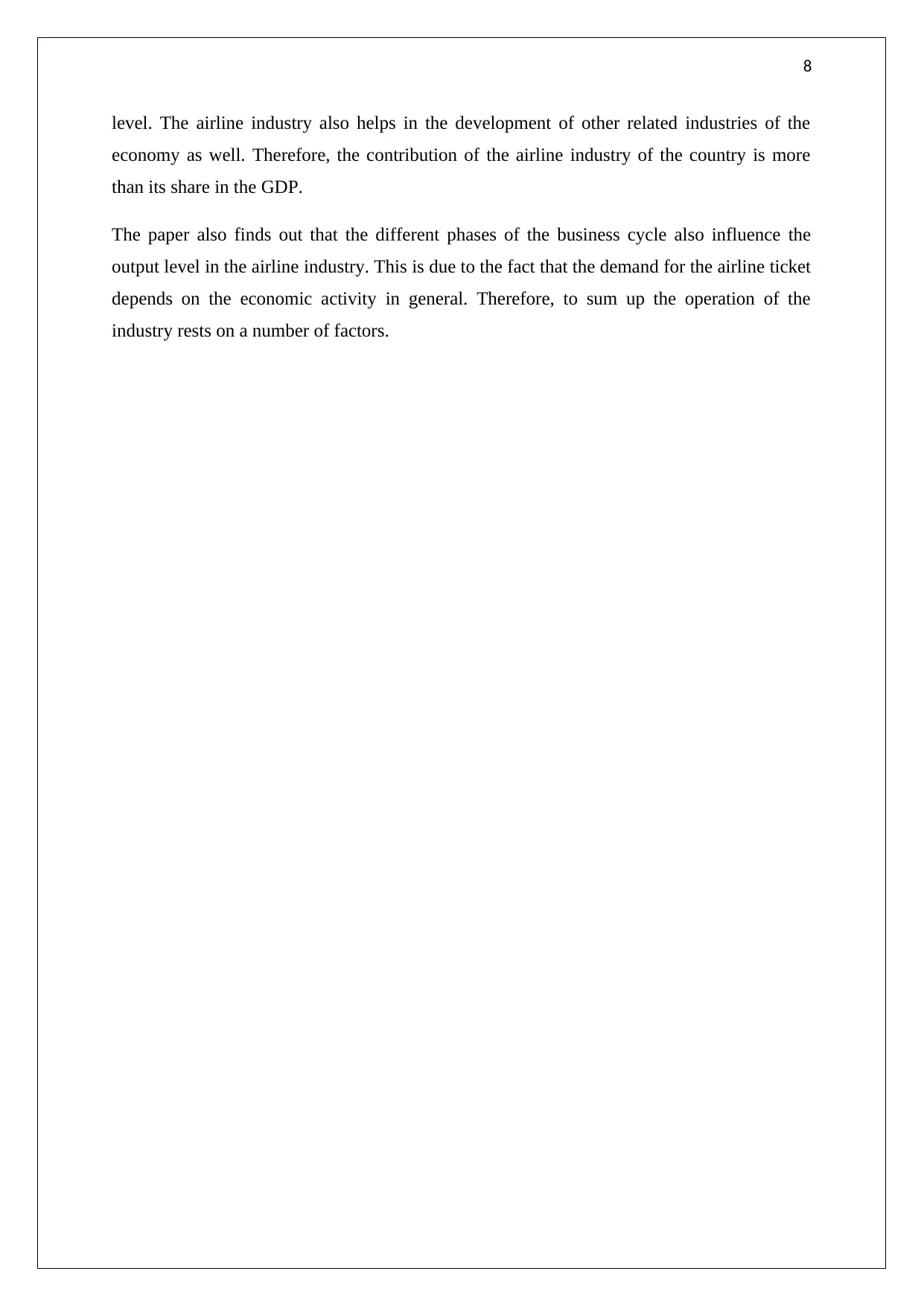
8
level. The airline industry also helps in the development of other related industries of the
economy as well. Therefore, the contribution of the airline industry of the country is more
than its share in the GDP.
The paper also finds out that the different phases of the business cycle also influence the
output level in the airline industry. This is due to the fact that the demand for the airline ticket
depends on the economic activity in general. Therefore, to sum up the operation of the
industry rests on a number of factors.
level. The airline industry also helps in the development of other related industries of the
economy as well. Therefore, the contribution of the airline industry of the country is more
than its share in the GDP.
The paper also finds out that the different phases of the business cycle also influence the
output level in the airline industry. This is due to the fact that the demand for the airline ticket
depends on the economic activity in general. Therefore, to sum up the operation of the
industry rests on a number of factors.
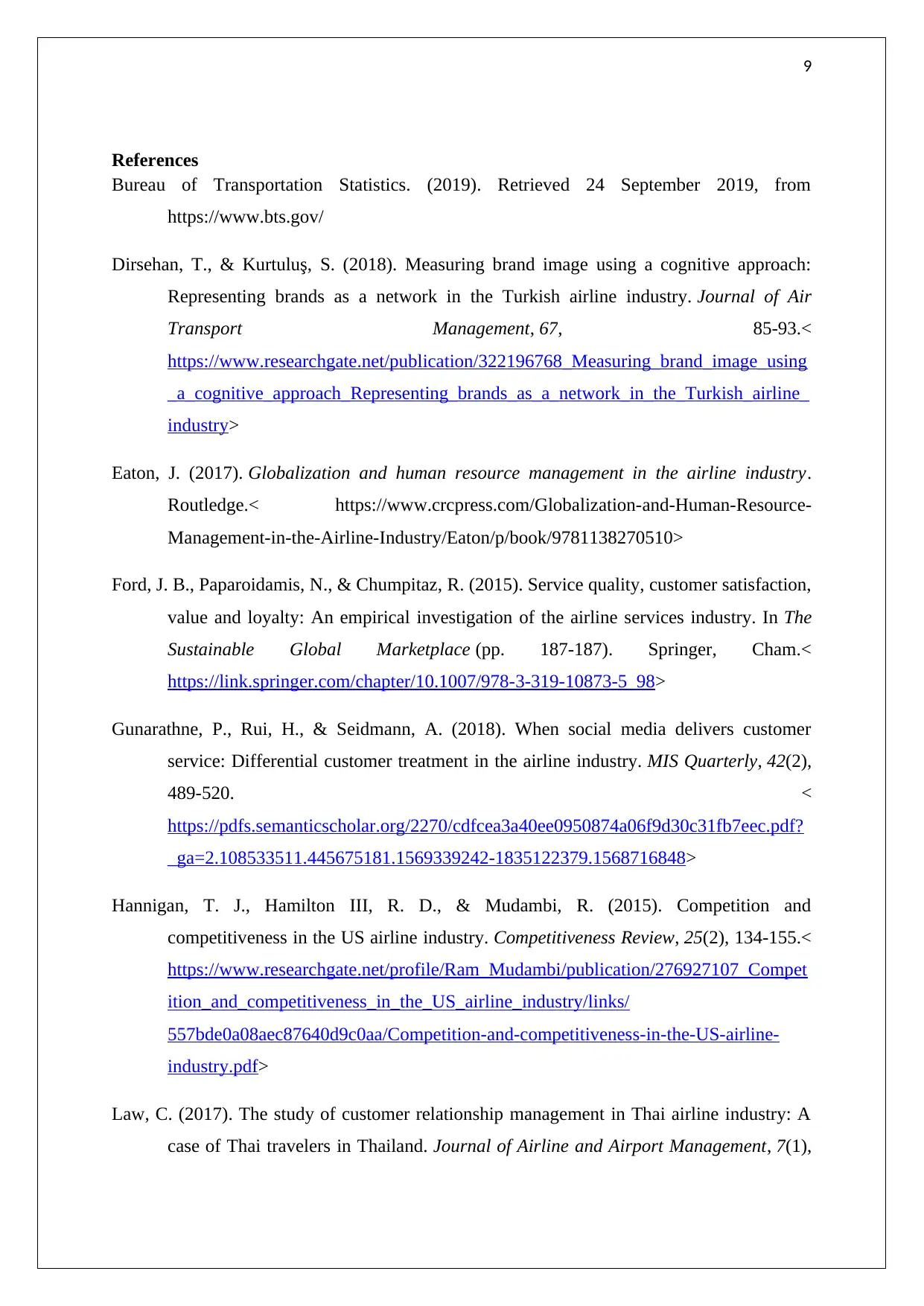
9
References
Bureau of Transportation Statistics. (2019). Retrieved 24 September 2019, from
https://www.bts.gov/
Dirsehan, T., & Kurtuluş, S. (2018). Measuring brand image using a cognitive approach:
Representing brands as a network in the Turkish airline industry. Journal of Air
Transport Management, 67, 85-93.<
https://www.researchgate.net/publication/322196768_Measuring_brand_image_using
_a_cognitive_approach_Representing_brands_as_a_network_in_the_Turkish_airline_
industry>
Eaton, J. (2017). Globalization and human resource management in the airline industry.
Routledge.< https://www.crcpress.com/Globalization-and-Human-Resource-
Management-in-the-Airline-Industry/Eaton/p/book/9781138270510>
Ford, J. B., Paparoidamis, N., & Chumpitaz, R. (2015). Service quality, customer satisfaction,
value and loyalty: An empirical investigation of the airline services industry. In The
Sustainable Global Marketplace (pp. 187-187). Springer, Cham.<
https://link.springer.com/chapter/10.1007/978-3-319-10873-5_98>
Gunarathne, P., Rui, H., & Seidmann, A. (2018). When social media delivers customer
service: Differential customer treatment in the airline industry. MIS Quarterly, 42(2),
489-520. <
https://pdfs.semanticscholar.org/2270/cdfcea3a40ee0950874a06f9d30c31fb7eec.pdf?
_ga=2.108533511.445675181.1569339242-1835122379.1568716848>
Hannigan, T. J., Hamilton III, R. D., & Mudambi, R. (2015). Competition and
competitiveness in the US airline industry. Competitiveness Review, 25(2), 134-155.<
https://www.researchgate.net/profile/Ram_Mudambi/publication/276927107_Compet
ition_and_competitiveness_in_the_US_airline_industry/links/
557bde0a08aec87640d9c0aa/Competition-and-competitiveness-in-the-US-airline-
industry.pdf>
Law, C. (2017). The study of customer relationship management in Thai airline industry: A
case of Thai travelers in Thailand. Journal of Airline and Airport Management, 7(1),
References
Bureau of Transportation Statistics. (2019). Retrieved 24 September 2019, from
https://www.bts.gov/
Dirsehan, T., & Kurtuluş, S. (2018). Measuring brand image using a cognitive approach:
Representing brands as a network in the Turkish airline industry. Journal of Air
Transport Management, 67, 85-93.<
https://www.researchgate.net/publication/322196768_Measuring_brand_image_using
_a_cognitive_approach_Representing_brands_as_a_network_in_the_Turkish_airline_
industry>
Eaton, J. (2017). Globalization and human resource management in the airline industry.
Routledge.< https://www.crcpress.com/Globalization-and-Human-Resource-
Management-in-the-Airline-Industry/Eaton/p/book/9781138270510>
Ford, J. B., Paparoidamis, N., & Chumpitaz, R. (2015). Service quality, customer satisfaction,
value and loyalty: An empirical investigation of the airline services industry. In The
Sustainable Global Marketplace (pp. 187-187). Springer, Cham.<
https://link.springer.com/chapter/10.1007/978-3-319-10873-5_98>
Gunarathne, P., Rui, H., & Seidmann, A. (2018). When social media delivers customer
service: Differential customer treatment in the airline industry. MIS Quarterly, 42(2),
489-520. <
https://pdfs.semanticscholar.org/2270/cdfcea3a40ee0950874a06f9d30c31fb7eec.pdf?
_ga=2.108533511.445675181.1569339242-1835122379.1568716848>
Hannigan, T. J., Hamilton III, R. D., & Mudambi, R. (2015). Competition and
competitiveness in the US airline industry. Competitiveness Review, 25(2), 134-155.<
https://www.researchgate.net/profile/Ram_Mudambi/publication/276927107_Compet
ition_and_competitiveness_in_the_US_airline_industry/links/
557bde0a08aec87640d9c0aa/Competition-and-competitiveness-in-the-US-airline-
industry.pdf>
Law, C. (2017). The study of customer relationship management in Thai airline industry: A
case of Thai travelers in Thailand. Journal of Airline and Airport Management, 7(1),
⊘ This is a preview!⊘
Do you want full access?
Subscribe today to unlock all pages.

Trusted by 1+ million students worldwide
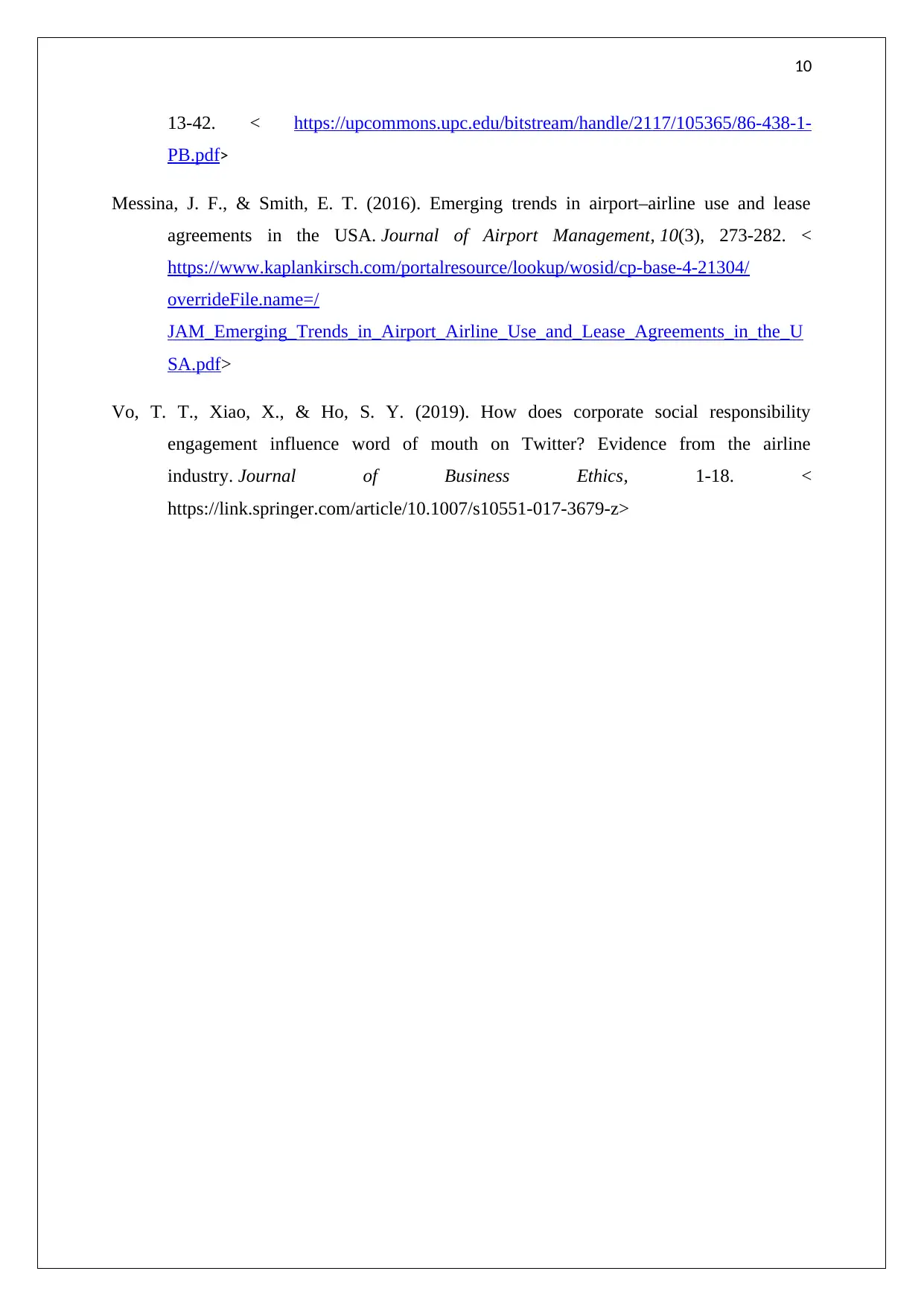
10
13-42. < https://upcommons.upc.edu/bitstream/handle/2117/105365/86-438-1-
PB.pdf>
Messina, J. F., & Smith, E. T. (2016). Emerging trends in airport–airline use and lease
agreements in the USA. Journal of Airport Management, 10(3), 273-282. <
https://www.kaplankirsch.com/portalresource/lookup/wosid/cp-base-4-21304/
overrideFile.name=/
JAM_Emerging_Trends_in_Airport_Airline_Use_and_Lease_Agreements_in_the_U
SA.pdf>
Vo, T. T., Xiao, X., & Ho, S. Y. (2019). How does corporate social responsibility
engagement influence word of mouth on Twitter? Evidence from the airline
industry. Journal of Business Ethics, 1-18. <
https://link.springer.com/article/10.1007/s10551-017-3679-z>
13-42. < https://upcommons.upc.edu/bitstream/handle/2117/105365/86-438-1-
PB.pdf>
Messina, J. F., & Smith, E. T. (2016). Emerging trends in airport–airline use and lease
agreements in the USA. Journal of Airport Management, 10(3), 273-282. <
https://www.kaplankirsch.com/portalresource/lookup/wosid/cp-base-4-21304/
overrideFile.name=/
JAM_Emerging_Trends_in_Airport_Airline_Use_and_Lease_Agreements_in_the_U
SA.pdf>
Vo, T. T., Xiao, X., & Ho, S. Y. (2019). How does corporate social responsibility
engagement influence word of mouth on Twitter? Evidence from the airline
industry. Journal of Business Ethics, 1-18. <
https://link.springer.com/article/10.1007/s10551-017-3679-z>
1 out of 10
Related Documents
Your All-in-One AI-Powered Toolkit for Academic Success.
+13062052269
info@desklib.com
Available 24*7 on WhatsApp / Email
![[object Object]](/_next/static/media/star-bottom.7253800d.svg)
Unlock your academic potential
Copyright © 2020–2025 A2Z Services. All Rights Reserved. Developed and managed by ZUCOL.





